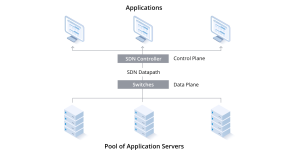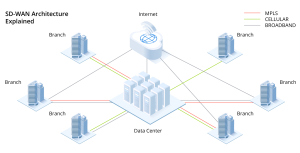In today’s hyperconnected business landscape, networking technologies like Software-Defined Networking (SDN) and Software-Defined Wide Area Networking (SD-WAN) are revolutionizing how organizations manage their infrastructure. While both leverage software-defined principles to enhance agility and efficiency, they address distinct challenges and use cases. For businesses evaluating their networking strategies, understanding the differences between SDN and SD-WAN is critical to making informed decisions.
1. Core Definitions and Objectives
Software-Defined Networking (SDN)
SDN is a centralized architecture that decouples the control plane (which directs traffic) from the data plane (which forwards traffic). By abstracting network management into a software layer, SDN enables administrators to programmatically control network behavior, optimize traffic flow, and automate configurations across switches, routers, and other hardware. Key features include:
-
Centralized management via a controller (e.g., OpenDaylight, Cisco ACI).
-
Dynamic resource allocation for improved scalability.
-
Open APIs for integration with third-party tools.
SDN is often deployed in data centers, enterprise campuses, and cloud environments to streamline operations and support complex workloads.
Software-Defined Wide Area Networking (SD-WAN)
SD-WAN applies software-defined principles specifically to wide area networks (WANs), which connect geographically dispersed locations (e.g., branch offices, data centers). Traditional WANs rely on rigid, expensive MPLS circuits, but SD-WAN replaces this with a flexible overlay that intelligently routes traffic over multiple connections (e.g., broadband, LTE/5G, MPLS). Key features include:
-
Traffic prioritization for critical applications (e.g., VoIP, SaaS tools).
-
Cost reduction by leveraging affordable internet links.
-
Zero-touch provisioning for rapid deployment.
SD-WAN is designed to simplify multi-site connectivity, enhance performance for cloud applications, and reduce reliance on legacy infrastructure.

2. Architectural Differences
| Aspect | SDN | SD-WAN |
|---|---|---|
| Scope | Focuses on internal networks (LANs, data centers). | Optimizes external connectivity between sites. |
| Control | Centralized controller manages entire network fabric. | Decentralized; edge devices make localized decisions based on policies. |
| Traffic Routing | Programmable flow rules for granular control. | Dynamic path selection based on application needs and link quality. |
| Deployment | Requires overhaul of existing hardware/software in some cases. | Overlay solution that works with existing infrastructure. |
3. Key Use Cases
When to Choose SDN
-
Data Center Automation: SDN excels in environments requiring rapid scaling, micro-segmentation, and seamless integration with cloud platforms (e.g., hybrid cloud setups).
-
Network Virtualization: Create isolated virtual networks for departments or tenants without physical hardware changes.
-
Research and Development: Ideal for labs or industries needing programmable networks for testing (e.g., telecom, IoT).
When to Choose SD-WAN
-
Multi-Branch Connectivity: Simplify management of dozens or hundreds of remote offices with centralized policies.
-
Cloud Migration: Ensure low-latency access to SaaS applications (e.g., Microsoft 365, Salesforce) and public clouds (AWS, Azure).
-
Cost Optimization: Replace expensive MPLS links with hybrid WANs combining broadband, cellular, and MPLS.
4. Strengths and Limitations
SDN Pros:
-
Unmatched flexibility for custom network workflows.
-
Supports advanced security policies (e.g., micro-segmentation).
-
Future-proofs infrastructure for emerging technologies.
SDN Cons:
-
High implementation complexity and upfront costs.
-
Requires skilled personnel to manage software-defined layers.
SD-WAN Pros:
-
Rapid deployment and reduced operational costs.
-
Enhances application performance for distributed teams.
-
Built-in security features (e.g., encryption, firewalls).
SD-WAN Cons:
-
Limited control over internal network hardware.
-
May struggle with ultra-low-latency requirements (e.g., high-frequency trading).
5. Can SDN and SD-WAN Work Together?
Absolutely. Many enterprises adopt SDN for core/data center networks and SD-WAN for edge/branch connectivity. For example:
-
An SDN controller could manage traffic within a headquarters’ data center, while SD-WAN optimizes connectivity to remote offices.
-
SD-WAN can feed performance data back to an SDN system, enabling end-to-end network automation.
6. Choosing the Right Solution for Your Business
-
Opt for SDN if: You need granular control over internal networks, plan to adopt DevOps-driven automation, or operate large-scale cloud/data center environments.
-
Opt for SD-WAN if: Your priority is simplifying multi-site WAN management, reducing MPLS costs, or improving cloud application performance.
For many organizations, a hybrid approach combining both technologies delivers the greatest value.

Conclusion
SDN and SD-WAN represent two sides of the software-defined revolution, each addressing unique challenges. SDN redefines how networks are built and managed internally, while SD-WAN transforms how businesses connect externally. By aligning these technologies with specific business needs—whether it’s agility, cost savings, or scalability—companies can future-proof their networks and stay competitive in a digital-first world.
Final Tip: Before investing, conduct a thorough assessment of your network’s pain points, budget, and long-term goals. Pilot projects or consultations with networking experts can help clarify the best path forward.


Comments are closed